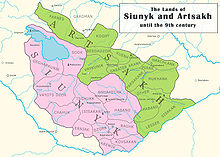Sangesur
Sangesur ( Armenian Զանգեզուր , Azerbaijani Zəngəzur ) is a historical region in the Caucasus . Its area largely coincides with that of today's Armenian province of Sjunik , but also extends into today's Azerbaijani Autonomous Republic of Nakhchivan and the current Armenian province of Vajoz Dzor . The name is historical and is used mainly unofficially today.
history
In ancient times, Sangesur was part of the historical Syunik Province of Greater Armenia . The historical province was significantly larger than the current Syunik province. During the eventful history of Armenia in the Middle Ages, it belonged to changing Islamic empires as well as to the Armenian State of the Bagratids , to the Kingdom of Georgia and the Mongolian and Turkish empires that followed it.
At the beginning of the 17th century, the Persian Shah Abbas I deported . part of the Armenian population inland Persia. In the 18th century there were several uprisings by the Armenian population against the Persian power. In the 19th century the region was annexed by the Russian Empire .
After the First World War, it was disputed between the Democratic Republic of Armenia and the Democratic Republic of Azerbaijan from 1918 to 1920 . In 1924 the area became largely part of the Armenian SSR within the Soviet Union . Then there was a significant emigration of Azerbaijanis from this area.
Cultural monuments
In addition to the famous Tatev monastery , numerous medieval churches, other monasteries (e.g. Gndevank , Wahanawank ) and castle ruins have been preserved in Sangesur .
economy
Sangesur is traditionally a mining area. The Sangesur copper and molybdenum combine , which has been 60% owned by the German Cronimet Mining AG since 2004 , is the largest taxpayer in Armenia.
Web links
- History of Sangasur (Aseri)



